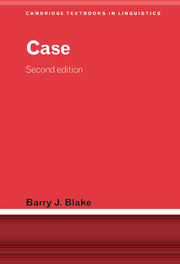Book contents
- Frontmatter
- Contents
- List of figures
- List of tables
- Preface to the Second Edition
- Preface to the First Edition
- List of abbreviations
- 1 Overview
- 2 Problems in describing case systems
- 3 Modern approaches to case
- 4 Distribution of case marking
- 5 Survey of case marking
- 6 Life cycle of case systems
- Notes
- Guide to terminology
- Guide to further reading
- References
- Author index
- Language index
- Subject index
2 - Problems in describing case systems
Published online by Cambridge University Press: 05 June 2012
- Frontmatter
- Contents
- List of figures
- List of tables
- Preface to the Second Edition
- Preface to the First Edition
- List of abbreviations
- 1 Overview
- 2 Problems in describing case systems
- 3 Modern approaches to case
- 4 Distribution of case marking
- 5 Survey of case marking
- 6 Life cycle of case systems
- Notes
- Guide to terminology
- Guide to further reading
- References
- Author index
- Language index
- Subject index
Summary
The traditional analysis
The western tradition of describing case systems can be traced back to the Greeks. Ancient Greek, like the other ‘older’ Indo-European languages, was a fusional inflecting language in which case marking could not be separated from number marking, where there was also some fusion of the stem and inflection, and where gender correlated closely with declensional type in the first (feminine) and second (masculine) declension. In other words, Greek was structurally parallel with Latin as illustrated in section 1.1. Given this kind of structure, it is not surprising that the Greek descriptions of case were based on the word rather than on stems and suffixes. The modern concept of the morpheme (the smallest meaningful, or better, smallest grammatical segment) is not very useful in languages where the expression of several grammatical categories has fused representation across the whole language, i.e. what Matthews calls cumulative exponence or cumulation (Matthews 1974/1991).
Cases were described in terms of what are called here case forms, where a case form is an inflected form of a noun. Since the inflection of case and number is fused, it would be more accurate to talk of case/number forms. The term case is from Latin cāsus, which is in turn a translation of the Greek ptōsis ‘fall’. The term originally referred to verbs as well as nouns and the idea seems to have been of falling away from an assumed standard form, a notion also reflected in the term ‘declension’ used with reference to inflectional classes.
- Type
- Chapter
- Information
- Case , pp. 18 - 46Publisher: Cambridge University PressPrint publication year: 2001



